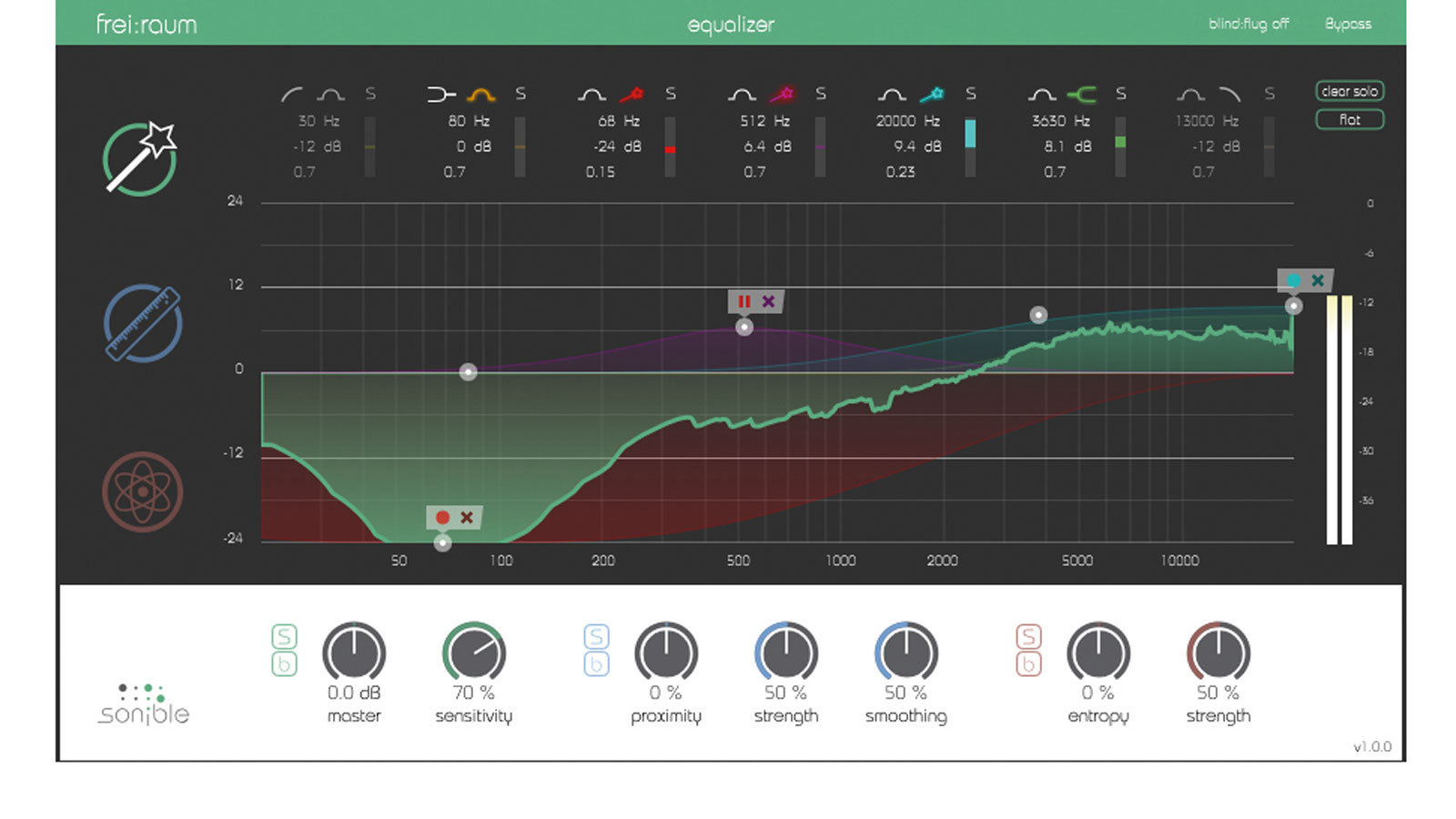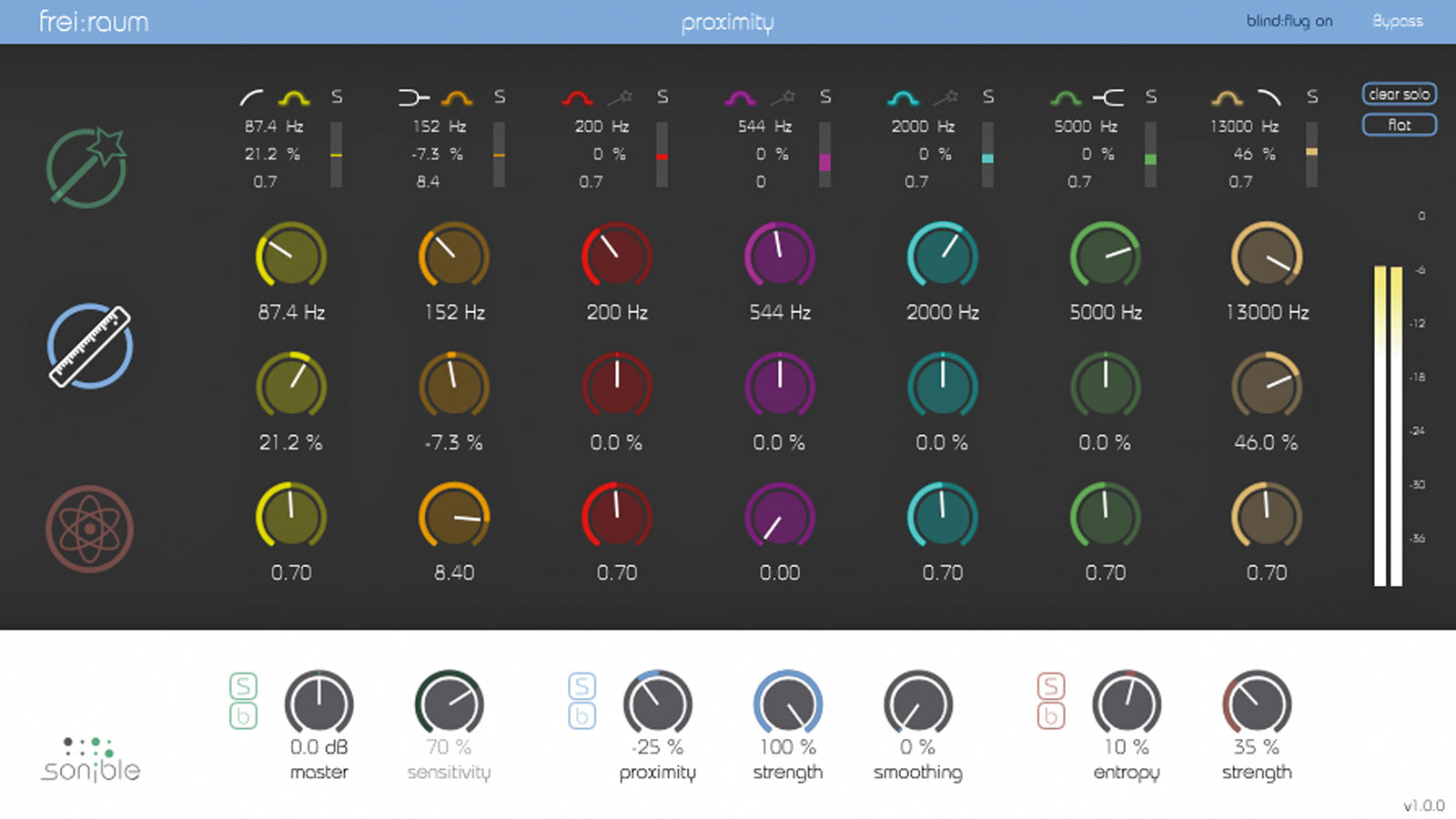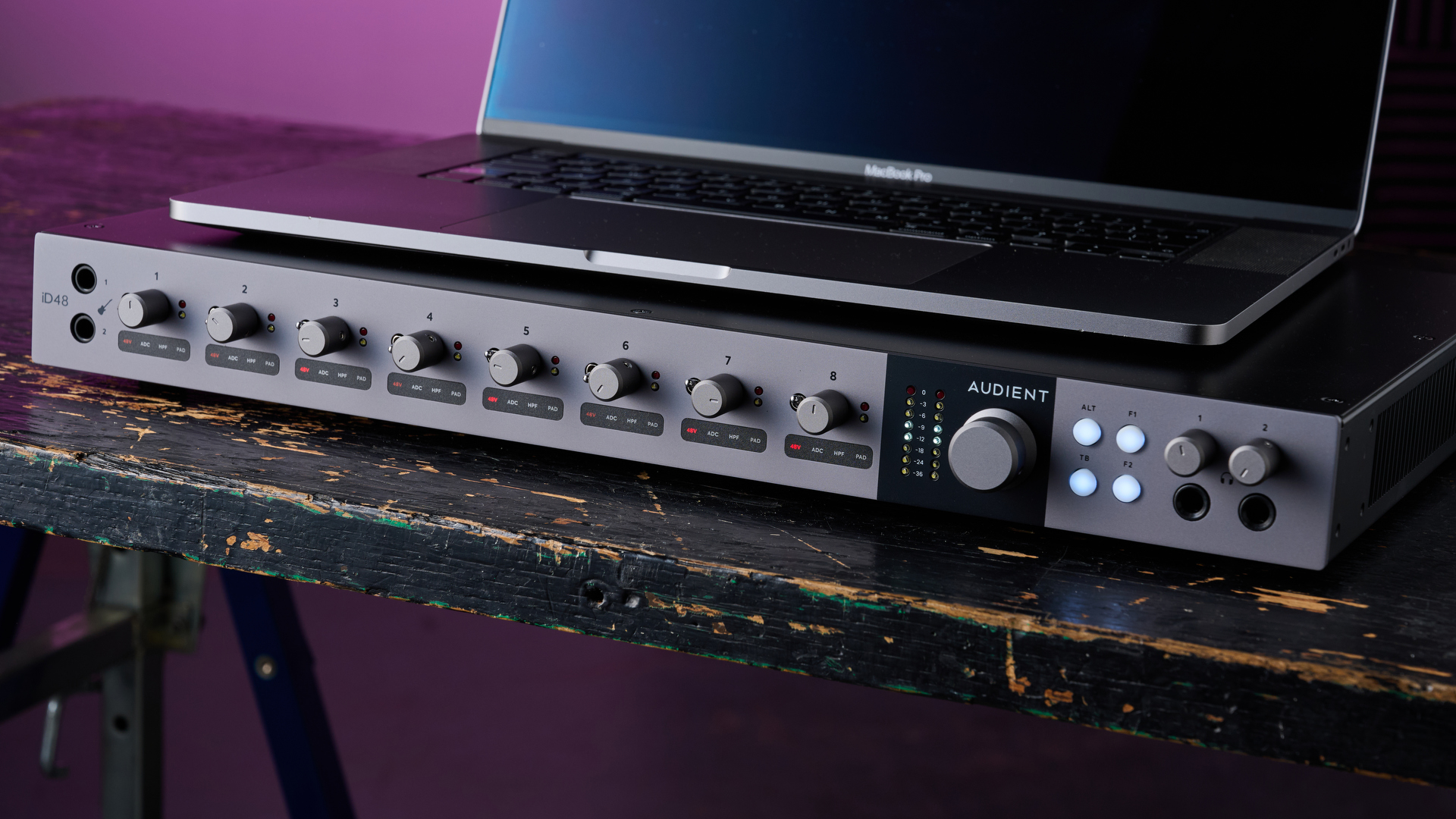MusicRadar Verdict
Utterly admirable in its approach, Frei:raum can be a bit too forward-thinking for its own good, but when it works, it's spectacular.
Pros
- +
Easy. Quick. Innovative. Familiar interface.
Cons
- -
Prone to audible artifacts. Less useful on non-acoustic signals. We'd like more bands with more flexibility. Can murder your CPU.
MusicRadar's got your back

Sonible Frei:raum

Three types of EQ

Blind:flug
Sonible's first software release attempts a new approach to EQ, based on some unusual, powerful algorithms. At the heart of Frei:raum is a seven-band linear-phase equaliser that anchors an otherwise very forward-thinking processor in a sense of familiarity.
What makes the plugin (VST/AU/AAX) unique are its trio of "interactive" layers, each one designed for a specialised task that conventional EQ wouldn't usually try to address, and the three of which can be used in any combination.
Smart enough
First up is the Smart EQ, which is designed to automatically adjust what Sonible call the "spectral balance" of the input signal. Essentially, it makes the signal's frequency curve smoother, squashing any resonances poking out from the overall shape of the spectrum, and bolstering weak spots by raising them.
"It's an innovative and impressive system that seriously speeds up the process of, say, taming the sharp resonance of a tambourine"
While this might sound bizarre at first - after all, how can a plugin know how you want your audio to sound - in use it actually makes a lot of sense, being essentially a faster route to the sort of corrective EQ we might normally spend ages dialling in with careful cuts and boosts.
Click the magic wand icon for any one of the three centre bands to switch it into Smart mode, then hit the record button that appears on it to activate learning mode for that band, and start playback of your source signal.
After a few seconds, the Smart EQ presents its idea of the optimal EQ curve (in incredible detail), and you can then use the familiar gain, frequency and Q controls to choose where and by how much to apply that curve to your signal.
You can boost or cut with more than one of the three Smart bands in the same frequency area, which is useful for crafting a nuanced curve - especially since each band has its own level of detail, set using the Sensitivity control.
Should you want to treat the entire spectrum with a single band, each band's Q setting can go wide enough to cover the full frequency range; and if you happen to like the elements the Smart EQ is trying to repress (or dislike those it's trying to bring out), you can use negative gain to apply the opposite curve.
It's an innovative and impressive system that seriously speeds up the process of, say, taming the sharp resonance of a tambourine; but we weren't always able to arrive at a satisfactory result due to the pre-ringing artifacts inherent in linear-phase processing.
On the one hand, the results can be super clear and polished, but on the other, highly transient material such as drum hits can suffer from noticeable smearing.
Proximity mein
The second of the three interaction layers is the Proximity EQ, which is designed to increase/ decrease perceived distance from the source signal.
Unlike the Smart EQ, this one doesn't require a learning phase, but just like the Smart EQ, you can use the three centre bands to apply varying amounts of the proximity effect to whichever frequency areas you like, each one defining the mix between the dry and ambient components of the signal.
"We found Proximity EQ to be very hit and miss on drums, although when it works well, it really is quite amazing"
It's another ambitious and forward-thinking system, but again, it doesn't always work quite as expected. The algorithm attempts to detect diffusion rather than just relying on dynamics and stereo imaging to split the signal, so if the ambient component isn't heavily diffuse, the results can be very patchy/inconsistent. There is a smoothing dial for the Proximity EQ layer (see Going global), but it doesn't always help much.
Proximity EQ really works best on acoustic instruments rather than electronic ones or digitally generated sounds, presumably because of the differentiation between direct and diffused signals. We also found it to be very hit and miss on drums, although when it works well, it really is quite amazing.
The final interaction layer is the Entropy EQ, which is much like the Proximity EQ but affecting the balance of tonal and atonal attributes rather than spatialisation. It's a very exciting concept that should enable plenty in the way of additional focus and clarity, but we couldn't help feeling disappointed by the unreliable results.
As well as the three interaction layers, Frei:raum can also be used as a regular linear- phase EQ, although there's no spectrum analyser in the display, and we were a little frustrated with the level of difficulty we had producing specific curve shapes using the available bands - especially the high and low shelves.
EQ expanded
In many ways, Frei:raum is much more than an EQ, since its specialised interactive layers offer far more than you'd expect from even the most advanced of conventional EQs.
However, while it looks like a promising plugin on paper, it doesn't quite pull off all the miracles it aims to without some serious side effects at least half the time. For the Smart EQ alone, it's a special product worthy of consideration - assuming you can live with the transient smearing.
We want to be more excited about Frei:raum as it offers a genuinely new way of treating audio. The problem, though, is that there are plenty of extraordinary plugins on the market these days, and we've come to expect utterly convincing results from any new one, particularly at this sort of price.
In that sense, Frei:raum misses the target as often as it hits it, which is a shame, but we can't wait to see how Sonible develops and refine its fascinating technology in the future - roll on v2!
Computer Music magazine is the world’s best selling publication dedicated solely to making great music with your Mac or PC computer. Each issue it brings its lucky readers the best in cutting-edge tutorials, need-to-know, expert software reviews and even all the tools you actually need to make great music today, courtesy of our legendary CM Plugin Suite.
Fantastic (free) plugins and how to use them: Full Bucket FB-3300
“It has the ingenious ability to give you easy routing to external hardware with no re-patching”: Audient iD48 review
“If this was real, it would be really impressive. But since it’s not real, it’s really impressive": Watch the bonkers four-note piano










